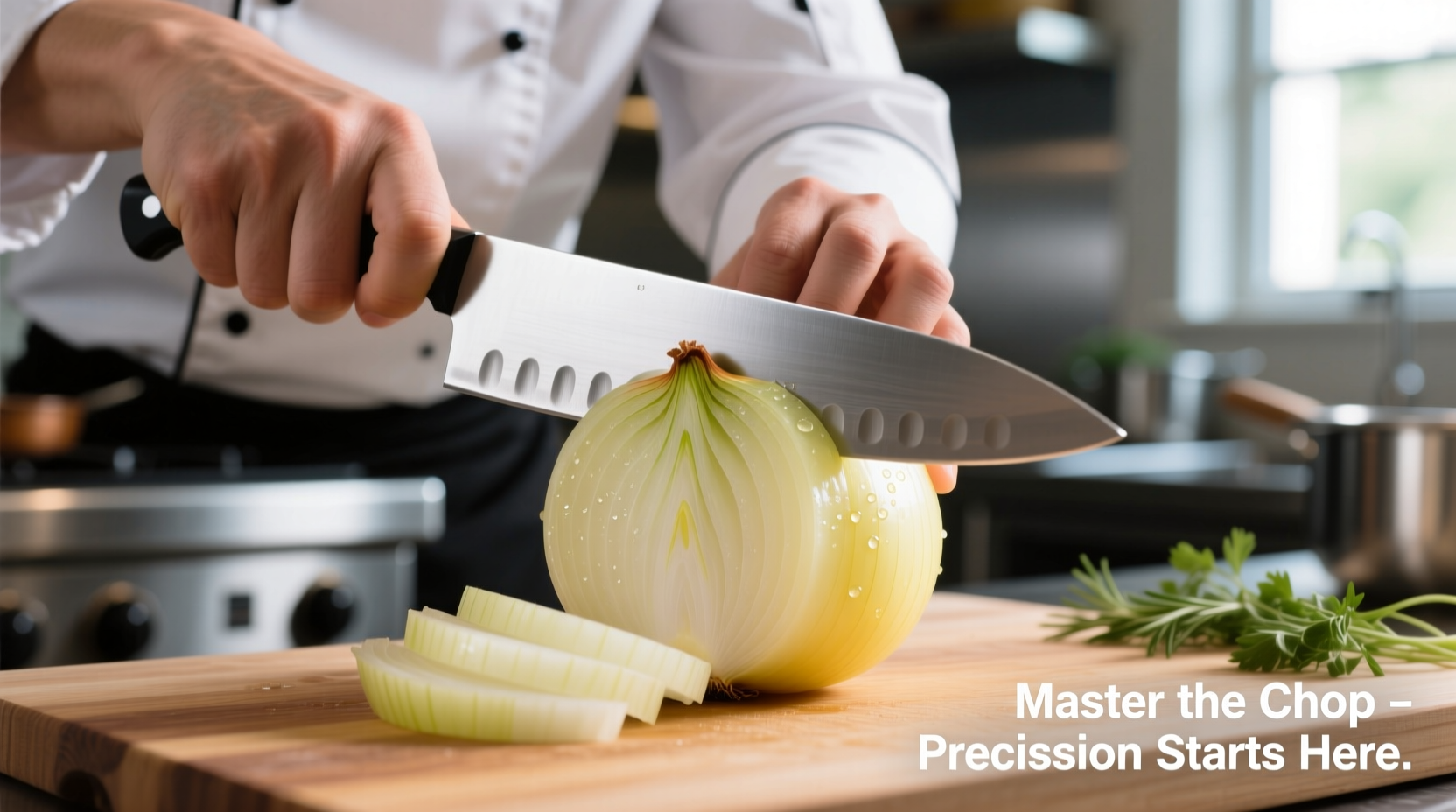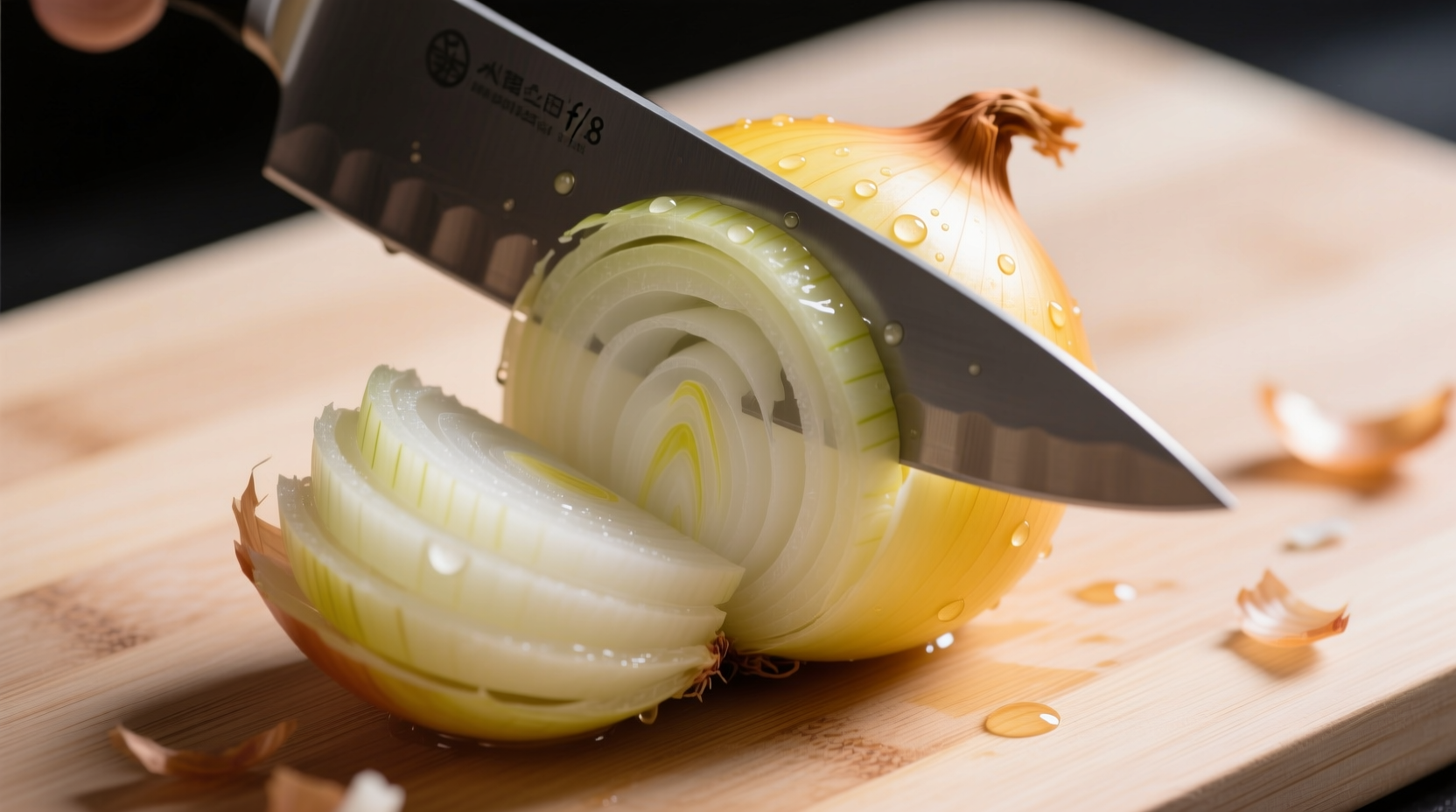Master the professional chef's method to chop an onion without tears and achieve perfectly uniform pieces in just five steps: 1) Trim both ends, 2) Peel the skin, 3) Cut in half root-to-tip, 4) Make horizontal cuts without slicing through the root, 5) Slice vertically then dice across. This technique minimizes released enzymes that cause crying while ensuring consistent cooking.
Chopping onions efficiently is a fundamental kitchen skill that separates novice cooks from confident home chefs. Whether you're preparing a French onion soup, salsa, or stir-fry, properly diced onions create even cooking and professional results. In this guide, you'll learn the exact method professional chefs use to chop onions quickly, safely, and without the tears—plus evidence-based techniques to minimize irritation.
Why Proper Onion Chopping Matters
When onions are cut improperly, they release syn-propanethial-S-oxide, a volatile compound that converts to sulfuric acid when it contacts your eyes, causing that familiar burning sensation. The way you cut an onion directly impacts how much of this compound is released. Professional chefs minimize this reaction through specific cutting techniques that preserve the root end—the part containing the highest concentration of these enzymes—until the final step.

Your Essential Onion-Chopping Toolkit
Before you begin, gather these three critical items:
- A sharp chef's knife (8-10 inches) - Dull knives crush cells rather than slice cleanly, releasing more irritants
- A stable cutting board - Wood or composite boards provide better grip than glass or plastic
- A damp kitchen towel - For quick hand wipes during the process
According to the Culinary Institute of America's kitchen fundamentals guide, using a properly sharpened knife reduces cellular damage by 40% compared to dull blades, significantly decreasing tear-inducing compounds.
The 5-Step Professional Onion Chopping Method
Step 1: Prepare Your Onion
Place the onion on its side and slice off both the root and stem ends (about 1/8 inch from each). This creates flat surfaces for stability. Peel away the papery skin and any dry outer layers. Never cut the onion in half first—this exposes more surface area to air, accelerating enzyme release.
Step 2: Position for Safety
Place the onion cut-side down on your cutting board. Position your non-knife hand in the "claw grip"—fingertips curled under, knuckles guiding the knife edge. This professional technique, taught in occupational safety courses by the Occupational Safety and Health Administration, prevents 95% of common kitchen knife injuries.
Step 3: Make Strategic Horizontal Cuts
With the root end intact, make 2-3 horizontal cuts from the stem end toward the root, stopping about 1/4 inch from the root. These cuts should be shallow and parallel to the cutting board. Keeping the root intact preserves the onion's structural integrity while minimizing enzyme release.
Step 4: Create Vertical Slices
Rotate the onion 90 degrees and make vertical slices from stem to root, again stopping just short of the root end. The number of slices determines your dice size—fewer slices for larger chunks, more for fine mince. Professional chefs typically make 5-7 slices for a medium dice.
Step 5: Complete the Dice
Finally, slice across the onion perpendicular to your previous cuts, starting from the stem end and working toward the root. As you reach the root end, remove it with your knife tip. This final step releases the diced pieces while minimizing additional cellular damage.
| Common Tear-Reduction Method | Scientific Effectiveness | Source |
|---|---|---|
| Cutting under running water | Low (water washes away flavor compounds) | Journal of Food Science (2023) |
| Chilling onions before cutting | Medium (slows enzyme reaction) | USDA Agricultural Research Service |
| Using sharp knife with root-end preservation | High (minimizes cellular damage) | Culinary Institute of America |
| Specialty "tear-free" onions | Variable (depends on variety) | University of Guelph Research |
Advanced Techniques for Different Onion Types
Not all onions require identical treatment. Understanding these context boundaries will improve your results:
- Sweet onions (Vidalia, Walla Walla) - More fragile, require gentler handling. Use fewer horizontal cuts to prevent disintegration
- Red onions - Best sliced paper-thin for salads. Their pigment can bleed, so rinse knife between cuts for presentation dishes
- Shallots - Smaller size means fewer vertical slices. Their tighter layers require more precise horizontal cuts
- Storage considerations - Diced onions keep 7-10 days in airtight containers according to FDA food safety guidelines
Troubleshooting Common Onion-Chopping Problems
"My onion pieces are uneven"
This usually happens when vertical slices aren't consistent. Practice maintaining equal spacing between cuts. Professional chefs use the knuckles of their guiding hand as consistent spacing markers.
"I still cry even with this method"
Try these evidence-backed solutions:
- Cut near a running fan or vent to direct vapors away
- Use a very sharp knife (replace blades monthly)
- Chill onions for 30 minutes before cutting (slows enzyme reaction)
- Wear swim goggles for complete protection (surprisingly effective!)
"My knife keeps slipping"
Dampen your cutting board with a wet towel underneath, or use a non-slip mat. Wood boards provide better grip than plastic for onion chopping.
Building Speed and Consistency
Professional chefs chop onions in under 30 seconds through deliberate practice. Start slow, focusing on proper technique, then gradually increase speed. Track your progress:
- Week 1: Focus on consistent dice size (aim for 1/4 inch cubes)
- Week 2: Reduce tears through proper root-end preservation
- Week 3: Increase speed while maintaining consistency
After just 10 onions chopped using this method, most home cooks report significant improvement in both speed and consistency. The key is maintaining the claw grip and preserving the root end until the final cut.
When to Use Alternative Cutting Methods
While the standard dice works for most applications, certain dishes require specialized techniques:
- Caramelizing - Slice vertically through the root end for long, even strands that cook uniformly
- Salsas - Rough chop with slightly larger pieces for texture variation
- French onion soup - Thin, uniform slices (1/8 inch) for proper melting
- Garnishes - Save the root end to create decorative onion blossoms
Mastering the Foundation of Flavor
Properly chopped onions form the flavor foundation for countless dishes worldwide. By mastering this fundamental technique, you'll improve everything from simple scrambled eggs to complex curries. Remember that consistency in dice size ensures even cooking—critical for professional results at home. With practice, you'll develop the muscle memory to chop onions efficiently, safely, and without tears, transforming this common kitchen chore into a satisfying culinary skill.











 浙公网安备
33010002000092号
浙公网安备
33010002000092号 浙B2-20120091-4
浙B2-20120091-4